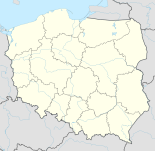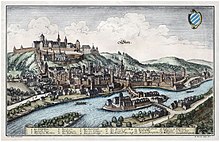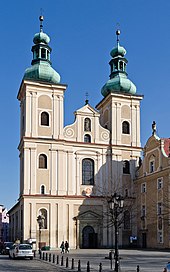Kłodzko
| Kłodzko | ||
|---|---|---|
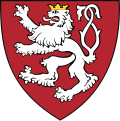 Kłodzko coat of arms Kłodzko coat of arms
|
|
|
| Basic data | ||
| State : | Poland | |
| Voivodeship : | Lower Silesia | |
| Powiat : | Kłodzko | |
| Area : | 25.00 km² | |
| Geographic location : | 50 ° 26 ′ N , 16 ° 40 ′ E | |
| Height : | 280-431 m npm | |
| Residents : | 26,845 (Jun. 30, 2019) |
|
| Postal code : | 57-300 | |
| Telephone code : | (+48) 74 | |
| License plate : | DKL | |
| Economy and Transport | ||
| Street : | E 67 Kudowa-Zdrój - Wroclaw | |
| Wałbrzych - Międzylesie | ||
| Rail route : | Wrocław – Międzylesie / Kłodzko – Kudowa Zdrój | |
| Next international airport : | Wroclaw | |
| Gmina | ||
| Gminatype: | Borough | |
| Surface: | 25.00 km² | |
| Residents: | 26,845 (Jun. 30, 2019) |
|
| Population density : | 1074 inhabitants / km² | |
| Community number ( GUS ): | 0208021 | |
| Administration (as of 2015) | ||
| Mayor : | Michał Piszko | |
| Address: | pl. Chrobrego 1 57-300 Kłodzko |
|
| Website : | www.um.klodzko.pl | |
Kłodzko [ ˈkwɔʦkɔ ] ( German Glatz [ ɡlaːʦ ]; Silesian Glootz ; Czech: Kladsko ) is the capital of the powiat Kłodzki in the Lower Silesian Voivodeship in Poland. It has 26,845 inhabitants (as of June 30, 2019). Until the 19th century Glatz was the capital of the County of Glatz , until 1945 the city belonged to the German Empire.
Geographical location
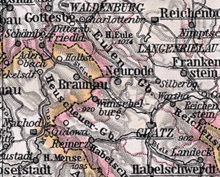

The city is located in Lower Silesia , about 80 kilometers south of the city of Wroclaw . The city is located a little north of the center of a wide basin of triangular shape with a tip pointing south, the Glatzer Kessel . The surrounding mountains are to the north, moving from northwest to southeast, the Owl Mountains ( Góry Sowie ), the Warthagebirge ( Góry Bardzkie ) and the Reichensteiner Mountains ( Góry Złote ), to the east and southeast the Bielengebirge ( Góry Bialskie ) and the Glatzer Schneegebirge ( Masyw Śnieżnika ) and to the southwest and west the Habelschwerdter Mountains ( Góry Bystrzyckie ), the Eagle Mountains ( Góry Orlickie ) and the Heuscheuergebirge ( Góry Stołowe ).
At the intersection of the pass crossings over these mountains, Kłodzko has a convenient location.
In the town, which is 294 m above sea level, there are two elevations, the Schlossberg (369 m) and the Schäferberg (346 m).
The Glatzer Neisse (Polish: Nysa Kłodzka ) flows through the town , from which the Mühlgraben ( Kanał Młynówka ) branches off. In the city area, the Reinerzer Weistritz ( Bystrzyca Dusznicka ) flow into the Glatzer Neisse from the left and the Hannsdorfer Wasser ( Jaszkówka ) and the Königshainer Bach ( Jodłownik ) from the right, and the stones ( Ścinawka ) north of the city from the left .
Kłodzko is located on the Wrocław – Międzylesie railway , which is part of the national long-distance line from Wroclaw to Prague . It has two train stations, the main train station ( Kłodzko Główne ) and the city train station ( Kłodzko Miasto ) , just outside .
history
The history of the city of Glatz and its political and ecclesiastical affiliation is closely linked to the history of the County of Glatz .
First mention and Middle Ages
The Bohemian chronicler Cosmas of Prague first mentioned the settlement in 981 as castellum Kladsko . On the rocky hill on the left bank of the Neisse, well suited for defense purposes, the Bohemian prince Slavnik , father of St. Adalbert , had a wooden castle built against Poland. This castle and the associated Czech market town Kladsko were besieged and destroyed several times in the dispute between Bohemia and Poland. After Glatz came to Poland for a short time in 1114, Soběslav of Bohemia had the castle fortified even more in 1129 in order to secure the important Prague – Nachod – Glatz – Wroclaw road. The Pentecostal Peace of Glatz , which was concluded in 1137, ended the disputes and strengthened the affiliation to Bohemia. The first known Burgrave of Glatz was Hroznata in 1169, followed by Ryvín / Rivinus in 1175 and Witigone Witiko von Prčice in 1177 .
In the 12./13. In the 19th century, Glatz developed into the center of the up-and-coming Glatzer country thanks to German settlers who were called into the country by the Bohemian King Ottokar II. Přemysl . A walled village was built below the castle hill, which was already known as urbs ( city ) in 1114 . The Johanniter Hospital for 1183, the Johanniterkommende around 1243, the Wenceslas Church northwest of the castle for 1184 and the Marienkapelle on the Schlossberg for 1194 are documented. The German form of the name Glatz is first recorded for the year 1223. In 1275 Glatz received the status of a city under Magdeburg law . In 1334 the city acquired the municipal bailiwick and thus its own jurisdiction.
From the 14th century the craftsmen were represented in the city council. Of significance were at this time cloth making , the linen weavers , several other crafts, beer production and trade. The outstanding position of the city was demonstrated by the fact that all other cities in the Glatzer country were subordinate to it with regard to taxes and services until the 15th century.
Glatz was able to defend himself in the Hussite Wars and was largely spared from destruction. After the Bohemian King Georg von Podiebrad acquired the Kłodzko Land in 1454 and raised it to a county in 1459, Kłodzko became the capital of the county of the same name. His son, Duke Heinrich the Elder of Münsterberg , the first ruling Count of Glatz, moved his residence to the city of Glatz and converted the castle into a palace.
Between the 15th and 18th centuries
During the Reformation Glatz was a center of the teachings of Schwenckfeld and other sects. In the 16th century, the Bohemian King Ferdinand I lifted the legal move to Magdeburg and made Prague the upper court for the towns of Kłodzko.
After the city council of Glatz recognized the election of the winter king Friedrich of the Palatinate and stood by him after the battle of the White Mountain , imperial troops occupied the city in 1622. They carried out punitive measures against the leaders of the battle and withdrew their privileges from other people . During the Thirty Years War , 930 of the then 1,300 buildings were destroyed. In addition to the devastation, there was a plague epidemic in 1635 , which killed 4,000 inhabitants, so that the city was largely depopulated. The plague raged again in 1680, causing 1,500 deaths.
During the Silesian Wars , Glatz was besieged and conquered several times. On January 8, 1741, the Prussians under Colonel Camas attacked the city, but they were repulsed. On January 9, 1742, the Prussians succeeded in taking the city; J. also the capture of the fortress. The Austrian counterattack took place in December 1744 under General Georg Olivier von Wallis ; in January 1745 the Austrians had to give up Glatz again. On July 26, 1760, Gideon Ernst von Laudon recaptured Glatz and the fortress after only eight days of siege. After the Peace of Hubertusburg in 1763, Glatz finally fell to Prussia. Despite the economic measures taken by Frederick the Great , the city only recovered slowly from the war damage , but at the end of the 18th century it was an important handicraft and trading center.
In the Napoleonic Wars during the Silesian Campaign , Glatz was succeeded by Friedrich Wilhelm von Götzen the Elder. J. to be defended and remained vacant.
19th century to the 2010s
In the second half of the 19th century, the population increased significantly due to newly developed building areas. At the same time, Glatz Fortress lost its military importance and served as a prison for political prisoners. Glatz, however, remained a garrison town. The opening up of traffic by the railway (1874 to Breslau , 1875 to Mittelwalde , 1880 to Waldenburg , 1890 to Rückers , 1897 Seitenberg , 1902 to Bad Reinerz and 1905 to Bad Kudowa ) resulted in a significant economic boom. Around 1900 Glatz had two Catholic churches, a Protestant church, a synagogue , a high school with a Konvikt , a number of different manufacturing plants and was the seat of a regional court.
In 1945 Glatz belonged to the district of Glatz in the administrative district of Breslau in the Prussian province of Silesia of the German Empire .
Towards the end of the Second World War , Glatz was occupied by the Red Army in the spring of 1945 and shortly afterwards placed under Polish administration. The city was renamed Kłodzko . The immigration of Polish migrants began. The German population was subsequently expelled by the local Polish administrative authority . Most of the Polish migrants came from the areas east of the Curzon Line , where they had belonged to the Polish minority, which had fallen to the Soviet Union as part of the “ westward displacement of Poland ” .
Between 1946 and 1989 the city was part of the People's Republic of Poland under the communist city administration , which became the Republic of Poland in 1989 . As a result of the restructuring of the voivodeships , Glatz belonged to the then Wroclaw Voivodeship from 1946 to 1975, to the Waldenburg Voivodeship from 1975 to 1998, and since then to the Lower Silesian Voivodeship .
During these years the city's industry developed above all. The population increased almost continuously until the turn of the millennium.
Often afflicted by floods , a flood of the century devastated the city in the summer of 1997 : within a few hours the Glatzer Neisse rose to a level of 8.71 m and flooded a large part of the city. With financial aid from the European Union after Poland joined the EU in 2004 and state funds, large parts of the old town were extensively renovated. Economic priorities at the beginning of the 21st century are trade, metal industry and the service sector.
Demographics
| year | population | Remarks |
|---|---|---|
| 1787 | 4330 | without the garrison (two regiments of infantry , one artillery company, one miner company) |
| 1816 | 5510 | with accessories; according to other information 7557 inhabitants (with the garrison) |
| 1825 | 6287 | including 861 Evangelicals, 57 Jews |
| 1840 | 7654 | thereof 1179 Evangelicals, 6415 Catholics, 60 Jews |
| 1843 | 7777 | at the end of the year, including 1,169 Evangelicals, 6506 Catholics, 102 Jews |
| 1852 | 10,656 | |
| 1867 | 11,821 | on December 3rd |
| 1871 | 11,541 | with the garrison (three battalions No. 18, one battalion Landwehr No. 11 and artillery ), including 1,500 Protestants; According to other data, 11,545 inhabitants (on December 1), including 1942 Protestants, 9374 Catholics, three other Christians, 226 Jews |
| 1890 | 13,501 | including 2,357 Evangelicals, 10,917 Catholics and 221 Jews |
| 1900 | 14,926 | with the garrison ( Infantry Regiment No. 38), including 2,564 Evangelicals and 183 Jews |
| 1925 | 16,563 | of which 3,461 Protestants, 12,867 Catholics, 18 other Christians and 125 Jews |
| 1933 | 19,000 | including 3,932 Evangelicals, 14,830 Catholics, 32 other Christians and 115 Jews |
| 1939 | 22,575 | of which 4,479 Protestants, 15,555 Catholics, 15 other Christians and 26 Jews |
- Number of inhabitants to date

In 2009 the population consisted of 53.4 percent (= 14,962) women and 46.6 percent (= 13,041) of men.
Structural urban development
The planned city layout with a grid-shaped street network was built on the left bank of the Neisse below the castle hill. A city wall with a series of towers, several gates and gates surrounded the village. In 1349 the Prague Archbishop Ernst von Pardubitz initiated the establishment of the Augustinian Canons of Glatz . The citizens built the town hall in 1366 on the 9200 m² ring . The preserved bridge gate was built on the model of Charles Bridge in Prague in the last quarter of the 14th century. The construction of the parish church of the Assumption of Mary , which began in the 14th century on the site of a previous church , was completed around 1430. At that time, Glatz had around 250 houses and around 4,000 inhabitants.
Frederick the Great had the castle demolished in the second half of the 18th century. With that, the remains of the medieval Bohemian border and royal castle also disappeared. In their place, the craftsmen built what was then a modern fortress, which was closed as a military facility in 1877. Between 1880 and 1911 the city gates and a large part of the city walls were demolished and streets and green spaces were laid out.
After the Second World War , when housing was urgently needed, new residential buildings and a church were built west of the old town. Historical buildings in the old town, however, fell into disrepair (including the houses on the upper side of the ring) because the money for renovations was not available.
coat of arms
The city coat of arms of Kłodzko shows a gold armored and crowned silver lion with a crossed double tail in red. Since the Kłodzko Land belonged to the Bohemian rulership and was elevated to a county in 1459, the coat of arms of which was two golden diagonal bars in red, the city has retained the symbol of its original membership of the Kingdom of Bohemia. The Bohemian lion appears in a large seal from the 13th century. It has been handed down to the present day.
Attractions
Church building
- Parish Church of the Assumption
- The Parish Church of the Assumption of the Virgin Mary ( Kościół Wniebowzięcia Najświętszej Maryi Panny ) was built from 1390 by the Prague Bauhütte from a legacy of the Prague Archbishop Ernst von Pardubitz on the site of a previous church and changed to Baroque style from 1624 to 1693. It is the most important place of Glatzer art and has a rich interior design, in which well-known artists were involved.
- The main altar was made from 1728 to 1729 according to a design by the Tyrolean architect Christoph Tausch , who also designed the altarpiece. The carvings were made by the Bamberg-born sculptor Johann Albrecht Siegwitz . The miraculous image of the Virgin Mary in the middle of the aedicule was painted around 1475.
- Michael Klahr the Elder Ä. created the Assumption Altar, the pulpit, the organ front and the confessionals.
- The Ignatius Altar was created by Michael Kössler from 1712 to 1713 .
- The Madonna with the Sparrow , which originally stood in the former provost church of the Augustinian monastery, is attributed to Peter Parler .
- The tumba of Ernst von Pardubitz, who was buried in the Glatzer parish church at his request, is made of red marble. It was created between 1364 and 1370 by an artist close to Peter Parler. The cenotaph for the same ( kneeling marble figure ) was struck by the Berlin sculptor Johannes Janda in 1870.
- The Minorite Church of St. Mary ( Kościół Matki Bożej Różańcowej ), in which a flood caused severe damage in 1997, was built between 1628 and 1631. The neo-renaissance furnishings are from the last quarter of the 19th century. In the refectory of the adjacent Franciscan monastery there are frescoes by Felix Anton Scheffler from 1744.
- The Church of St. George ( Kościół Św. Jerzego ) is mentioned as early as 1275. It was rebuilt several times and served as a Protestant garrison church from 1834 to 1945.
- On the way to Koenigshain ( Wojciechowice ) stands the Marian pilgrimage site “Maria Trost” on the Spittelberg .
Glatz Fortress
The fortress Glatz , a former Bohemian castle was rebuilt in the 15th century to a castle and after the Thirty Years' War to a fortress. The fortress is located on a 369 meter high mountain on the northern side of the old town of Kłodzko.
Secular structures
- The town hall ( Ratusz ) was built from 1887 to 1890 according to plans by the architect Ewald Berger in the neo-renaissance style. It is located on the Glatzer Ring and was built around the preserved town hall tower from 1654.
- The Marian column was created in 1682 to commemorate the victims of the plague based on designs by the Glatzer sculptor Hans Adam Beyerhoff .
- The former Jesuit college was built from 1654 to 1690 according to plans by Carlo Lurago by the builders Francesco Canevale and Andrea Carove. After the Jesuit order was abolished , it was a Catholic grammar school from 1787 to 1945. Today it is called Liceum Ogólnokształcące .
- The former Jesuit convict was built in 1664 by A. Carove based on a design by Carlo Lurago. It has housed the Muzeum Ziemi Kłodzkiej (German: Museum of the Glatzer Land) since the 1990s .
- The castle hill with the former fortress ( Twierdza Główna ) offers a wide view of the city and the southern Kłodzko basin .
Bridge gate bridge
The Bridge Gate Bridge ( Most świętego Jana ) is a stone arch bridge in the old town of Glatz, which was designed on the model of Prague's Charles Bridge and spans the city's Mühlgraben, a branch of the Glatzer Neisse. In the baroque period she received six stone figures as bridge decorations.
Fountains and parks
- East of the town hall stands the baroque lion fountain from 1700 with the double-tailed Bohemian lion.
- The city also advertises an aqua park as well as other park attractions such as the JUPI Park on the grounds of the fortress, which offers adventure for children and teenagers.
Rural commune of Kłodzko
The city of Kłodzko is the administrative seat of the rural municipality of Kłodzko , but it does not belong to it as an independent municipality. The rural community has 17,142 inhabitants on an area of 252.25 km² (as of June 30, 2019) and is divided into 35 school administration offices.
Personalities
Honorary citizen
- Georg Stolle (1938-2020), German politician and mayor of Bensheim , honorary citizen of Kłodzko (2019)
sons and daughters of the town
- Ernst von Pardubitz (1300–1364), Archbishop of Prague
- Georg Emmerich (1422–1507), pilgrim, merchant, mayor of Görlitz
- David Origanus (1558–1628), German mathematician, philologist and astronomer
- Charles II of Liechtenstein-Kastelkorn (1623–1695), Bishop of Olomouc
- Johann Christoph Schambogen (1636–1696), professor and rector of the Charles University in Prague
- Johann Christoph Pezel (1639–1694), composer and town piper
- Johann Georg Heinsch (1647–1712), Bohemian painter
- Kaspar Knittel , (1644–1702) Jesuit, philosopher and mathematician and rector of the Charles University in Prague
- Michael Friedrich Graf von Althann (1680–1734), Bishop of Waitzen, Viceroy of the Kingdom of Naples and Sicily, cardinal
- Johann Franz Hoffmann (1699/1701 - around 1766), baroque painter
- Andreas Faulhaber (1713–1757), Roman Catholic clergyman
- Friedrich Wilhelm Riemer (1774–1845), classical philologist, secretary to Johann Wolfgang von Goethe
- Franz Weiß (1778–1830), violist and composer
- Karl Seydelmann (1793–1843), German actor
- Friedrich Wilhelm Hemprich (1796–1825), German naturalist and zoologist
- Anton Ludwig (1798–1869), German theologian, from 1846 to 1869 grand dean and vicar of the County of Glatz
- Rudolf von Carnall (1804–1874), German mining engineer
- Paul Rogalla von Bieberstein (1835–1907), Prussian major general and genealogist
- Octavio von Zedlitz-Neukirch (1840–1919), German politician, member of the Reichstag, member of the Prussian House of Representatives
- Robert von Dobschütz (1850–1927), royal Prussian major general
- Robert Kosch (1856–1942), Prussian officer, general
- Emma Ihr (1857–1911), German politician and trade unionist
- Curt von Kronhelm (1859–1937), Prussian major general
- Alfred Janeba (1869–1951), German politician (Center Party)
- Robert Karger (1874–1946), Silesian dialect poet, writer and journalist
- Leopold von Wiese (1876–1969), German economist and sociologist
- Otto Reche (1879–1966), German anthropologist and ethnologist
- Carl Bruck (1879–1944), German doctor and dermatologist
- Rudolf Richter (1881–1957), German paleontologist
- Georg Wache (1886–1977), German politician, member of the state parliament in Lower Saxony
- Albrecht Schubert (1886–1966), German officer, most recently general of the infantry in World War II
- Renée Sintenis (1888–1965), German sculptor and graphic artist
- Peter Jeschke (1895–1979), German lawyer and local politician
- Karl Franz Klose (1897–1984), German photographer
- Georg Neugebauer (1901–1984), German politician, member of the Reichstag
- Friedrich-Wilhelm Geier (1903–1965), German lawyer and judge at the Federal Court of Justice
- Annelies Kupper (1906–1987), German opera singer
- Gerhard Hirschfelder (1907–1942), youth chaplain for the former County of Glatz and resistance fighter against National Socialism
- Ilse R. Wolff (1908–2001), German-English editor and publisher
- Walter Kalot (1909–1996), German sculptor, graphic artist and painter
- Fritz Rudolf Wüst (1912–1993), German ancient historian
- Ludwig Friedel (1917–2007), German industrial clerk, photographer, sculptor and painter
- Theodor Hubrich (1919–1992), Roman Catholic theologian and bishop
- Hans Richard Schittny (1924–2009), German pharmacist and writer
- Rosemarie Scheurlen (* 1925), German politician in Saarland (FDP)
- Gerhard Steffens (1927–1998), German politician (CDU)
- Siegfried Kristen (1928–2019), German actor
- Bernhard Neugebauer (1932–2015), German diplomat and politician (GDR)
- Wiegand Pabsch (* 1932), German lawyer and diplomat
- Joachim Sobotta (1932–2017), German journalist and lawyer
- Dieter Augustin (1934–1989), German actor and comedian
- Peter Becker (1934–2018), German music teacher
- Klemens Jockwig (* 1936), German Redemptorist, Roman Catholic theologian
- Herbert F. Schubert (1931–2011), German dancer and choreographer
- Peter Hentschel (1939–2006), German lawyer
- Gert Kreutzer (* 1940), German Scandinavian scholar and translator
- Volker Issmer (* 1943), German historian and writer
- Bogdan Zdrojewski (* 1957), Polish politician, MEP
- Monika Muskała (* 1966), Polish author and translator
- Jan Daniec (1968-2007), Polish football player
- Jakub Szulc (* 1973), Polish politician, 2008–2012 Deputy Minister of Health
- Weronika Nowakowska-Ziemniak (* 1986), Polish biathlete
- Sebastian Witek (* 1986), Polish biathlete
- Łukasz Krawczuk (* 1989), Polish athlete
They were held prisoner in the fortress of Glatz
- Wenzel von Jägerndorf (around 1440–1479), 1452–1464 Duke of Jägerndorf and 1464–1474 Duke of Rybnik
- Georg Popel von Lobkowicz (around 1551–1607), Bohemian nobleman and politician
- Friedrich Freiherr von der Trenck (1727–1794), Prussian officer and adventurer
- Heinrich Bürgers (1820–1878), convicted in the Cologne communist trial in 1852
- Wilhelm Joseph Reiff , convicted in the Cologne communist trial in 1852
- Peter Nothjung (1821–1866), convicted in the Cologne communist trial in 1852
- Karl Liebknecht (1871-1919), German politician, anti-militarist and lawyer
- Sophie Ursinus (1760–1836), serial killer
Town twinning
- Carvin (France), since 1980
- Bensheim (Germany), since 1996
- Fléron (Belgium), since 1995
- Náchod (Czech Republic), since 1995
- Rychnov nad Kněžnou (Czech Republic), since 2008
- Limanowa (Poland), since 2018
The city is a member of the Federation of European Napoleonic Cities .
literature
- Johann Georg Knie : Alphabetical-statistical-topographical overview of the villages, towns, cities and other places of the royal family. Preusz. Province of Silesia. 2nd Edition. Graß, Barth and Comp., Breslau 1845, pp. 818-820 .
- Friedrich Gottlob Leonhardi : Earth description of the Prussian monarchy , Volume 3, Part 1, Halle 1792, pp. 212-214 .
- Karl August Müller: Patriotic images, or history and description of all castles and knight palaces in Silesia and the county of Glatz. Second edition, published by Carl Flemming , Glogau 1844, pp. 88–99. .
- Aloys Bach : Documented church history of the Graffschaft Glaz. From primeval times to our days. In addition to an appendix: Historical statistical representation of all Gläzer parishes and churches with their spiritual leaders, as well as the schools in 1841. Gustav Fritz, Breslau 1841.
- Peter Güttler: The Glatzer Land. A travel guide to the landscape, art and culture of the Kłodzko Mountains / Ziemia Kłodzka in Silesia. Aktion West-Ost eV, Düsseldorf 1995, ISBN 3-928508-03-2 , pp. 37-36.
- Arno Herzig , Małgorzata Ruchniewicz : History of the Glatzer Land. DOBU-Verlag et al., Hamburg et al. 2006, ISBN 3-934632-12-2 .
- Dehio Handbook of Art Monuments in Poland. Silesia. Deutscher Kunstverlag, Munich et al. 2005, ISBN 3-422-03109-X , pp. 452-460.
- Hugo Weczerka (Hrsg.): Handbook of the historical places . Volume: Silesia (= Kröner's pocket edition . Volume 316). Kröner, Stuttgart 1977, ISBN 3-520-31601-3 , pp. 116-123.
- Arne Franke, Katrin Schulze: Palaces and mansions in the county of Glatz: An architecture and park travel guide , Bergstadtverlag Wilhelm Gottlieb Kern , Görlitz 2009, ISBN 978-3-87057-297-6 .
Web links
- City website
- Glatz at Kulturwerk Schlesien
- City view in the travel album of Count Palatine Ottheinrich 1536/37
- Historical and current photos of the fortress
- 360 ° aerial panorama of the city
Individual evidence
- ↑ a b population. Size and Structure by Territorial Division. As of June 30, 2019. Główny Urząd Statystyczny (GUS) (PDF files; 0.99 MiB), accessed December 24, 2019 .
- ^ Website of the city (BIP), Burmistrz ( Memento of December 8, 2014 in the Internet Archive ), accessed on January 21, 2015.
- ^ Aloys Bernatzky : Lexikon der Grafschaft Glatz , MARX Verlag Leimen / Heidelberg 1984, p. 78
- ↑ Vaterländische Bilder, in a history and description of the old castle festivals and knight palaces of Prussia , p. 98.
- ↑ a b Glatz . In: Meyers Großes Konversations-Lexikon . 6th edition. Volume 8, Bibliographisches Institut, Leipzig / Vienna 1907, pp. 12–13 .
- ↑ Glatz-Klodzko on www.polish-online.com
- ↑ Friedrich Gottlob Leonhardi : Earth Description of the Prussian Monarchy , Volume 3, Part 1, Halle 1792, pp. 212-214 .
- ↑ Alexander August Mützell and Leopold Krug : New topographical-statistical-geographical dictionary of the Prussian state . Volume 2: G – Ko , Halle 1821, p. 37, see Glaz .
- ^ A b Gustav Neumann : The German Empire in geographical, statistical and topographical relation . Volume 2, GFO Müller, Berlin 1874, pp. 180-181 , item 12.
- ↑ Johann Georg Knie : Alphabetical-statistical-topographical overview of the villages, spots, cities and other places of the royal family. Prussia. Province of Silesia, including the Margraviate of Upper Lusatia, which now belongs entirely to the province, and the County of Glatz; together with the attached evidence of the division of the country into the various branches of civil administration. Melcher, Breslau 1830, p. 926 .
- ↑ a b Johann Georg Knie : Alphabetical-statistical-topographical overview of the villages, towns, cities and other places of the royal family. Preusz. Province of Silesia. 2nd Edition. Graß, Barth and Comp., Breslau 1845, pp. 818-820 .
- ^ Kraatz: Topographical-statistical manual of the Prussian state . Berlin 1856, p. 183 .
- ^ A b Royal Statistical Bureau: The municipalities and manor districts of the province of Silesia and their population. Based on the original materials of the general census of December 1, 1871. Berlin 1874, pp. 146–147, item 1 .
- ↑ a b c d Michael Rademacher: German administrative history from the unification of the empire in 1871 to the reunification in 1990. glatz.html # ew39gltplusatz. (Online material for the dissertation, Osnabrück 2006).
- ↑ grafschaft-glatz.de
- ↑ Glatz Aquapark
- ↑ Jupipark Klodzko ( Memento from August 15, 2015 in the Internet Archive )
- ^ City partnerships Kłodzko
